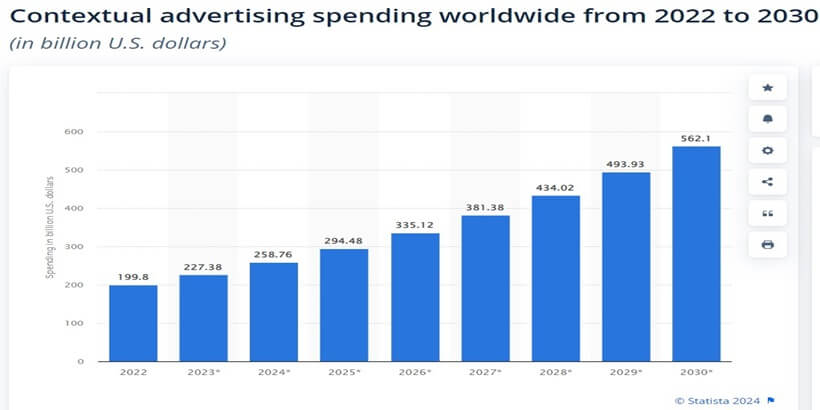What is Contextual Targeting? & Its Importance in the Context of Ads
Table of Contents
What is Contextual Targeting? & Its Importance in the Context of Ads
It is vital to understand that, in the world of online advertising, it is increasingly essential to assert that the content in which advertising is embedded is relevant. The reason for this is that there is so much content online that an ad’s viewers, in other words, the audience, must be determined by the content that is watched by the viewers and what that audience is reading about.
What is Contextual Targeting?
Contextual advertising is a form of web advertisement that targets any web page, app, or other digital platform based on the content of existing users. In other words, contextual promotion primarily says there is no need to rely on the users’ information or demographics, removing the ads, or showing them if they are connected with the context in which the ads are displayed. For example, If someone reads an article
Methods of Contextual Targeting
Contextual targeting methods refer to the techniques used in digital advertising to display ads based on the “context” of content being viewed by a user online.
Commonly used contextual targeting methods include:
- Keyword targeting: Targeting of ads to web pages or other digital content that consists of keywords relevant to the product of the advertiser. There are different strategies within this method: an advertiser selects specific keywords relevant to the offering, and an ad is shown on a website or content that contains these keywords.
- Topic targeting: Unlike keywords, in this case, an ad is shown on a website or content that belongs to a specific topic or theme. In topic targeting, an advertiser selects topics and themes corresponding to the advertising message. Therefore, ads are served on any website or content that uses these topics no matter the keywords used.
- Contextual Category Targeting: This method involves targeting ads to specific categories or types of content. Advertisers select predefined categories or content types that align with their target audience or campaign goals. Ads are then displayed on web pages or content that fall within those categories.
How does contextual targeting work?
Firstly, the advertiser selects anything that corresponds to his target audience or the campaign objective. Further, the ads are placed on any website, web page, or information material that is associated with this category. It is possible due to the use of advanced algorithms and natural language processing that is being applied to review the text of a page and the output – this is exactly how algorithms of Mielot and Metis work. Different forms of contextual advertising usually analyze the text of a website and additional media material and select keywords or semantic elements to play an ad on.
Contextual vs. Behavioral Targeting

This table presents detailed differences between contextual and behavioral targeting based on what they are, basis & how they work, Approach, flexibility, and ad relevance, privacy perspective, and examples:
| Aspect | Contextual Targeting | Behavioral Targeting |
|---|---|---|
| Definition | Targets ads based on the context of the content being viewed or engaged with. | Targets ads based on the user’s past behavior, interests, and online activity. |
| Basis of Targeting | Content relevance (keywords, topics, categories). | User behavior (browsing history, search queries, interactions). |
| Real-Time vs. Historical Data | Typically uses real-time data about the current content being viewed. | Relies on historical data about the user’s behavior and preferences. |
| Flexibility | Offers limited flexibility as it depends on the context of the content. | Provides more flexibility as it can target users across different contexts based on their behavior. |
| Ad Relevance | Ads are relevant to the content being viewed at the moment. | Ads are tailored to the user’s interests and past behavior, potentially relevant across various content contexts. |
| User Privacy | Generally less intrusive as it doesn’t rely on tracking individual user behavior. | It can raise privacy concerns as it involves tracking and analyzing user behavior across websites. |
| Use Cases | Useful for reaching users interested in specific topics or contexts. | Effective for retargeting users who have shown interest in a product or service. |
| Examples | Keyword targeting, topic targeting, contextual category targeting. | Retargeting ads, personalized recommendations, dynamic ads. |
Components that contextual targeting algorithms consider include:
- Keyword analysis: The framework identifies topical words of the textual content and serves advertisements as it was taking after such keywords.
- Sentiment analysis: Sentiment-based or -tone detection strategies can permit the placement of advertisements that correspond well to the passionate content of the content.
- Topic modeling: The approach of a more complex topic displaying process can get the general idea of the content like the core topic and hence create a more specific targeting for advertising.
- Semantic analysis: Through dealing with the contextual meaning and its associations with words by the system, it can therefore coordinate advertisements with the most relevant context.
Importance of Contextual Targeting in Context to Ads
Contextual targeting in advertising is like the base that makes indeed the most delicious noodles with a fulfilling texture. It’s the essence of the processes used in placing advertisements in front of the appropriate audience as well as how these advertisements are shown not as it were on the premise of timing but also on the particular content the audience is seeing. Pitting pizza advertisements against people with a craving for Italian cuisine, but with noodle advertisements against individuals with a craving for Japanese food is a great example of competition.
In fact, contextual remarketing also applies respectfulness in advertising. It agrees with online clients by not bothering them with advertisements that have nothing to do with the content they are seeing, but contextual targeting chooses individuals only based on their interest in the content they already have, showing the right coming advertisement follows. Hence, it increases brand loyalty among clients since they are cheerful, and it also builds trust between brands and users.
Another significant component of contextual targeting that should be mentioned is its capacity to work in diverse platforms and formats. Be it contextual advertising for search ads, show advertisements, local advertisements, or video advertisements, contextual targeting is going to be accommodating in all cases, so it becomes an easy tool for marketers to deal with all channels that they use and make the right choice on where to place their ads.
Additionally, this contextual targeting keeps brands from unsuitable advertisement areas clear. With the help of context analysis, marketers can keep away from the situations of setting their advertisements aside from flawed and unsuitable material that might harm their brand image. Such a brand safety point of view is not only connected with the reputation of the brand but is moreover vital for the proper placement of advertisements that can bring positive emotions.
Some of the Benefits of Contextual Targeting are:
- Improved significance and engagement: Serving relevantly significant advertisements, which tie in with the user’s current interface and is shown on the substance they are devouring, progress focusing on which increments the likelihood of producing clicks and engagement.
- Improved user experience: Contextualized advertisements supply an unparalleled user involvement in which advertisements carry content that is true, important, and surely not intrusive.
- Increased click-through rates (CTRs) and conversions: Important advertisements are more like to be clicked on due to the reality that they are more likely to be open to the client leading to higher click-through rates and, in this way, more conversions for the sponsor.
- Respectful data practices: Context-oriented advertising not only mining the contents for analysis instead of following client data that may create a privacy concern among consumers.
- Brand safety: Through the use of contextual advertisements, marketers ensure that a brand is not implementing random advertisement targeting, but instead, ideal arrangement, which makes a difference in avoiding associations of the company with questionable or improper substance, eventually securing the brand’s image and reputation.
- Scalability: This sort of advertising permits advertisements to be placed in different digital environments, web, and content sorts, which gives both relevance and visibility at a high level.
Conclusion
The context of online advertising will advance as the use of contextual targeting increases which is a key component for conveying a particular, relevant, and appropriate advertisement experience that will resonate with the customer. By applying leading-edge algorithms and content analyzing tools, their messages are bound to be noticed and become significant for their potential audiences. At last, it should also offer assistance them add value for both its clients and brands.
I hope you enjoyed reading this article!
Please check out our other recent article:

